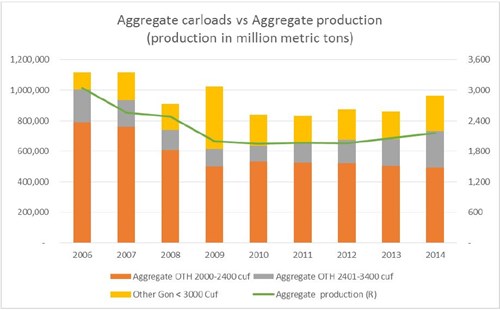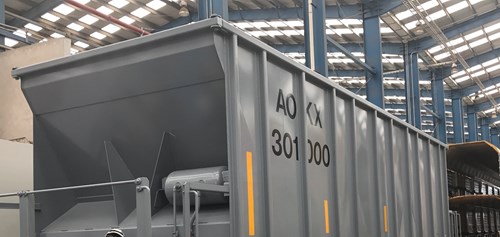 Aggregates Industry Background:
Aggregates Industry Background:
Mining and transporting construction aggregates is arguably one of the oldest industries on the planet. From earliest times, man has sought to improve his shelter, and later, his mobility, by mining rocks, sand and gravel to build houses and to improve paths and tracks for wheeled vehicles. Historically, the closest sources were used to source construction aggregates, be it a river bed or a rocky outcrop, in an effort to minimize the energy or manpower required to transport such heavy materials.
In general, nothing has changed. Aggregates are just as dense, relatively low value, and require substantial energy, plus heavy machinery, to mine and transport the quantities required by a modern industrial economy. Where possible, the closest sources are exploited, usually transported by trucks due to short travel distances. But there are exceptions to this, and the number of exceptions is growing.
The Gulf Coast region of the US has never had a local supply of hard rock as a result of the largely alluvial nature of the soil. The vast majority of aggregates for the Gulf Coast are imported by rail or water, sometimes from more than 400 miles away. This flow of materials has operated for many years, so much so that it can be said that Houston is built on rock from Oklahoma and Texas hill country. Similar situations exist in other aggregate-poor and low-lying coastal areas throughout the world.

Aggregates come in all shapes and sizes.
As urban areas have grown and sprawled into suburbs, nearby sources of construction aggregates are depleted or can no longer be expanded because of zoning concerns. In many cases, old sand and gravel pits are transformed into lakes for leisure activities, while in some cases rail distribution sites take up part of the footprint of the old quarry.
As materials science knowledge has increased, concrete makers and highway engineers have become more specific in their requirements for various aggregates with unique characteristics. In particular, both cement manufacturing and highway paving have become far more sophisticated. Input materials are analyzed to the molecular level to find the best combinations for strength and longevity, reducing upgrade project frequencies and corresponding arduous budget appropriations for state highway paving programs and other public works construction projects.
Thus, while there might be rock close at hand to a demand center, the buyer may well pay a premium for a rail-hauled product if it has a longer service life. In the concrete market, the complex chemical reaction of concrete making is well-understood, and construction companies need material that is free of harmful minerals. Again, a transportation premium may be worth the expense if the final product fetches a higher price. These market dynamics reinforce a trend towards growing volumes of crushed rock and aggregates being moved longer distances in railcars.
Rail Transportation of Aggregates:
Statistics published by the US Geological Survey and the Association of American Railroads indicate an emerging upward trend in aggregates production correlated with stronger railcar loadings since 2010. Whether this trend will continue depends on a combination of the health of the overall economy and specific government action to procure additional funds for infrastructure maintenance and new construction.

Historical relationship between aggregate loadings and aggregate production.
Two types of railcars are used for crushed stone and aggregates, open top hoppers and flat-bottomed gondolas. An efficient operation sizes the cubic capacity of the railcar to the tonnage and density of the product. However, there are still operators that use inexpensive “hand me down” cars that are overweight and over length, but are most likely fully depreciated. Most of these cars have, at best, 45-degree slope sheets, necessitating car shakers to fully discharge the load. Many of these steel coal cars are of 1960s or 1970s vintage and are being retired soon due to their age and condition.
Where volumes justify the capital expense and where space is available for moving railcars over an unloading pit, the biggest throughput can be obtained with bottom dump hopper cars. For greater speed of operation and for operator safety, the car of choice has air-operated bottom doors with push-button controls. In order to provide optimal flow, matching the speed of railcar discharge with the capacity of the conveyor belts and stackers of the unloading site, each set of car doors is individually controlled.

Greenbrier’s Aggregate Hopper. See details here.
Hopper railcars can be used in conjunction with a mobile conveyor system, which can be a self-contained unit hauled by a small truck or fully integrated with a truck. Unloading is often slow, as these units have less take away capacity than large fixed facilities. However, with their ability to load directly into trucks, these units can be effective for small volumes or temporary sites.
Gondola cars are a more common alternative when track space is limited or when there is a need for a temporary unloading site. Until the late ’90s, gondolas for aggregate service were primarily standard 100 ton “mill” gondolas. These legacy railcars limited the delivery capacity to less than two tons of material per foot of track available. In 1999/2000, gondolas designed specifically for aggregate service were introduced. Aggregate gondolas are typically 42-feet long and have a capacity of up to 115 tons. This allows for an increase in delivered tons per foot of track to 2.7 (versus less than 2 in legacy “mill” gons), greatly increasing efficiency at both loading and unloading sites, as well as improving the ratio of lading to tare weight.
Greenbrier Aggregate Offerings:
Greenbrier’s approach to railcar engineering targets an optimal balance of structural integrity and longevity with maximum loading capacity and ease of use for the railcar operator. Greenbrier has a long history and reputation for providing the railroad industry with cars that minimize lifetime ownership costs.

Greenbrier’s Aggregate Gondola. See details here.
For aggregate unit train configurations in particular, the cost of taking individual railcars out of service for defects and repairs is very high. A car that is out of service cannot earn revenue. Our designs aim to reduce the likelihood of defects, damage, and repair for aggregates shippers and railroads alike.
In addition to manufacturing and leasing aggregate railcars, Greenbrier manages both our own lease fleet and the fleets of many other railcar operators throughout North America. With more than 270,000 railcars under management, we know a thing or two about what it takes to keep a fleet operating smoothly.
Through Greenbrier Management Services (GMS), we act as a fleet manager for many of our customers, handling day-to-day railcar logistics. GMS takes care of tracking every car, maintenance and repairs, and every other aspect of managing a fleet of railcars. Our objective is to optimize the utilization of the fleet and minimize repair expenses and downtime, freeing up time and money to be more effectively deployed elsewhere.

